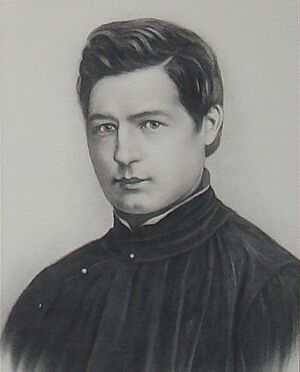Théophane Vénard facts for kids
Quick facts for kids SaintThéophane Vénard MEP |
|
|---|---|

Painting of Théophane Vénard in chains, at the Paris Foreign Missions Society.
|
|
| Martyr | |
| Born | 21 November 1829 Saint-Loup-sur-Thouet, Diocese of Poitiers, France |
| Died | 2 February 1861 (aged 31) Tonkin, Vietnam |
| Venerated in | Roman Catholic Church |
| Beatified | 2 May 1909, Rome, Kingdom of Italy by Pope Pius X |
| Canonized | 19 June 1988, Vatican City, Rome, Italy by John-Paul II |
| Feast | 24 November |
Jean-Théophane Vénard (born November 21, 1829, in Saint-Loup-sur-Thouet, France – died February 2, 1861, in Tonkin, Vietnam) was a brave French Catholic missionary. He was part of a group called the Paris Foreign Missions Society. He traveled far from home to share his faith in Indo-China (which includes modern-day Vietnam).
Jean-Théophane was one of many Catholic martyrs who died for their beliefs in that region. He was later declared a saint by Pope John Paul II in 1988, along with nineteen other martyrs.
Contents
Early Life and Education
Théophane Vénard was one of six children. His father was a schoolmaster in their local village. Théophane's brother, Eusebins, later became a priest in a nearby village. His sister, Melanie, joined a religious community.
When he was a young boy, Théophane read about the death of another missionary, Jean-Charles Cornay. This story inspired him to want to become a missionary himself.
In 1841, Théophane began studying at a college in Doué-la-Fontaine. He learned the basics of Latin from his local priest. At age eighteen, he started studying philosophy at a seminary in Montmorillon. After that, he studied theology in Poitiers. He then joined the Paris Seminary for Foreign Missions. He became a priest on June 5, 1852.
Journey to Vietnam
Théophane left Paris for the Far East on September 19, 1852. His ship sailed from Antwerp, Belgium. After a stormy journey, he arrived in Singapore on New Year's Day, 1853.
He spent three weeks in Singapore before being sent to Hong Kong. There, he stayed for fifteen months, learning the Chinese language. However, his plans changed. He was then sent to help Bishop Pierre-André Retord at his mission in West Tonkin, which is in northern Vietnam.
Facing Persecution
Soon after Théophane arrived in Vietnam, a new royal law was made against Christians. This meant that bishops and priests had to hide. They found safety in caves, thick forests, and other secret places.
Théophane went into the mountains. He continued his work as a priest, mostly at night, to avoid being caught.
On November 30, 1860, he was captured and taken to the city of Phủ Lý. From there, he was moved to the main office in Hanoi. He was brought before a mandarin, who was a government official. Théophane refused to give up his faith or step on a Fumi-e, which was a sacred image used to identify Christians. He was sentenced to be beheaded.
Imprisonment and Martyrdom
Théophane remained a prisoner until February 2, 1861. During this time, he lived in a cage. From his cage, he wrote letters to his family. These letters were filled with hope and joy, as he looked forward to his death for his faith.
Sometimes, in the evening, he was allowed to leave his cage. He would hear confessions from other priests in the prison. He would also walk around, praying the rosary and singing hymns. The guards were amazed by his peacefulness.
Jean-Théophane Vénard was beheaded on February 2, 1861. As he walked to his execution, he sang psalms and hymns. He told his executioner, who wanted his clothes and asked what he would give to be killed quickly: "The longer it lasts the better it will be."
After his death, his head was displayed on a pole. Christians later secretly took his head, and it is now honored in Tonkin. His body rests in a special crypt at the motherhouse of the Paris Foreign Mission Society in Paris, France.
Becoming a Saint
The process to declare him a saint began in Rome in 1879. He was declared "Blessed" on May 2, 1909. Later, he was officially made a saint on June 19, 1988, by Pope John Paul II.
The Roman Martyrology, a book listing saints, describes him: "In Hanoi, Tonkin, now Viet Nam, Saint Jean-Theophane Vénard, priest of the Paris Society for Foreign Missions and martyr, who, after six years of clandestine ministry marked by hardship and suffering, locked in a cage and condemned to death under Emperor Tự Đức, went peacefully to his martyrdom."



